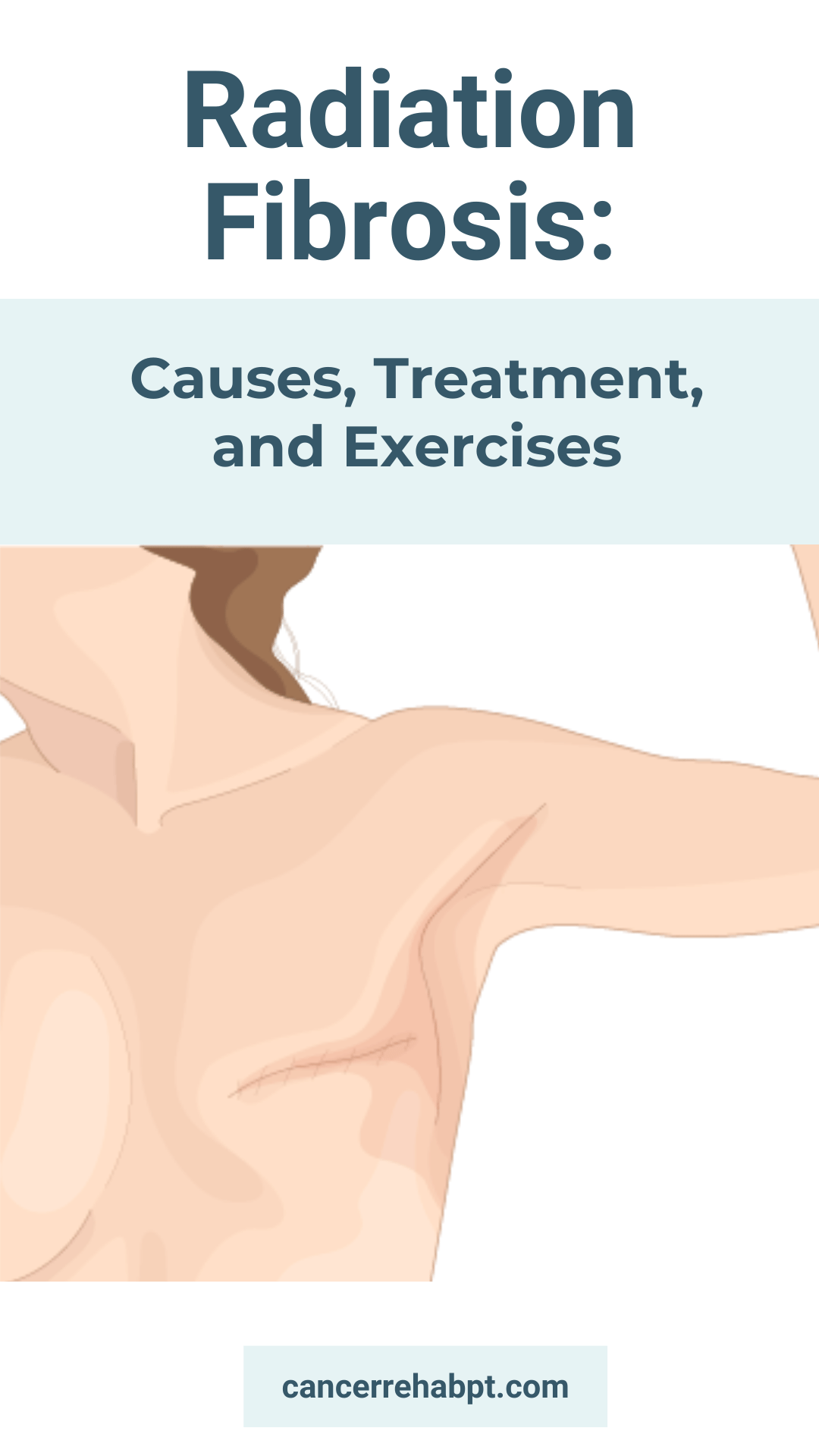
Radiation fibrosis is a condition that develops as a result of radiation therapy, a common treatment for various types of cancer, including breast cancer.
While radiation therapy is effective in targeting and destroying cancer cells, it can also affect surrounding healthy tissues, leading to complications such as radiation fibrosis.
If you develop radiation fibrosis, you may struggle with unwanted symptoms like restricted range of motion, pain, skin changes, tightness, and other physical limitations. However, there are ways to treat radiation-induced fibrosis and help you get your strength and mobility back.
👋 Hello, I’m Kelly Sturm, a Doctor of Physical Therapy (PT, DPT) and a Board-Certified Oncology Specialist, CLT-LANA. I share helpful resources for those living with and after breast cancer and lymphedema. Subscribe to my YouTube Channel, get my free guides, or learn more about my comprehensive program Breast Cancer Rehab.
Key Takeaways
- Radiation fibrosis is a side effect of radiation therapy, characterized by symptoms like stiffness, skin changes, and pain in the affected area.
- The exact causes of radiation fibrosis syndrome are unknown, but cancer patients who receive high radiation doses and undergo longer radiation therapy have a higher risk of developing the condition.
- Stretching, manual therapy techniques, skincare, and physical exercise are effective ways of managing radiation fibrosis and improving your quality of life.
- You can find detailed techniques and exercises for managing radiation fibrosis in my program Breast Cancer Rehab.
What Is Radiation Fibrosis?
Radiation fibrosis is a side effect of radiation therapy, a common treatment for various types of cancer. While the primary goal of radiation therapy is to destroy cancer cells, it can also unintentionally damage nearby healthy tissues, leading to radiation-induced skin fibrosis.
Broadly speaking, radiation fibrosis is when body tissue (muscles, tendons, ligaments, skin, etc.) gets damaged, hardens, or develops scarring as a result of radiation therapy.
Restricted range of motion, pain, tightness, and skin changes are all symptoms of radiation-induced fibrosis. Radiation fibrosis can occur months or even years after the completion of radiation therapy.
Causes of Radiation Fibrosis
The exact causes of radiation fibrosis are not fully understood, but there are various theories.
The most probable explanation of why radiation fibrosis syndrome occurs is that radiation therapy damages both cancerous and normal tissue.
Healthy cells in the radiated area may experience DNA damage and cellular changes, triggering an inflammatory response.
It’s more common to see radiation fibrosis develop in cancer patients who received a high radiation dose and a longer radiation treatment compared to patients who had just a few sessions with a lower dose. There are also possible genetic risk factors, with some cancer patients being more prone to tissue and skin changes than others.
For more information on radiation-induced fibrosis, watch my YouTube video ↓
//www.youtube.com/embed/BLT0ep3caxs?wmode=opaque
How to Get Rid of Tightness and Pain after Radiation Therapy
Breast Radiation Fibrosis Symptoms
Recognizing the symptoms of radiation-induced fibrosis is crucial for early treatment and suppressing chronic inflammation. Common symptoms include:
- Restricted Range of Motion: Fibrous tissue buildup can limit joint movement, leading to stiffness and reduced flexibility.
- Pain and Discomfort: Patients may experience pain and discomfort in the irradiated area, affecting their overall quality of life.
- Skin Changes: Changes in skin texture, such as thickening and hardening, are common manifestations of radiation fibrosis.
It’s important to note that the onset and severity of these symptoms can vary among individuals, and some people may experience few or no symptoms at all. Moreover, the time between radiation therapy and the development of radiation-induced fibrosis can range from several months to years.
Treatment for Radiation Fibrosis
If you have developed radiation-induced fibrosis, you don’t have to accept pain, discomfort, and limited range of motion as your new normal. There are steps you can take to effectively manage and improve radiation fibrosis symptoms after cancer treatment.
There are four main types of treatment for radiation fibrosis: stretches, manual therapy, skincare, and movement.
I explain all of them in great detail and with practical examples in my comprehensive program Breast Cancer Rehab.
1. Stretches for Radiation Fibrosis
Radiation fibrosis builds up like scar tissue. As a result, gently stretching muscles and tendons can help muscles maintain their length, minimize tightness, improve flexibility, and enhance overall mobility in affected areas.
Focus your stretches on the affected areas, like the muscles in the front of your chest, your neck, or the rotator cuff of your shoulder. Hold the stretch for 30 seconds and up to 2 minutes, but make sure to keep it gentle. You may feel some tightness, but there should be no pain or straining.
2. Manual Therapy for Radiation Fibrosis
Hands-on manual therapy techniques, such as massage-like movements and myofascial release, can be beneficial when managing radiation-induced fibrosis. Common manual therapy techniques include:
- Soft Tissue Mobilization: Gentle manipulation of skin, muscles, and connective tissues to break down radiation fibrosis buildup and improve tissue flexibility.
- Myofascial Release: Focused movements to release tension in the fascia, the connective tissue surrounding muscles and organs, to restore normal tissue function.
- Joint Mobilization: Targeted movements to improve the range of motion in affected joints and reduce stiffness.
- Massage Therapy: Massage movements to promote blood circulation, reduce muscle tension, and alleviate discomfort.
- Scar Tissue Massage: Massage movements to address and minimize scar tissue formation and improve tissue mobility.
Manual therapy techniques should not be deep or intensive. It’s important to avoid adding more inflammation to the affected area or causing further damage, so focus on doing the techniques for just 5-10 minutes a day to start seeing positive changes.
→ I show different manual therapy techniques and stretches in detail in my program Breast Cancer Rehab.
I created the program to share my physical therapy knowledge with more people and it includes the same exercises that I use with my patients in the clinic.
3. Skin Care for Radiation Fibrosis
You may already know that skin care is necessary during radiation, but it’s also important after radiation therapy is complete and when managing radiation-induced fibrosis.
During radiation therapy, it’s common for skin to get damaged. Many cancer patients develop blistering, burns, or other skin changes, along with inflammation and sensitivity. Radiation-induced fibrosis can thicken and harden tissue, but it can also make it more sensitive.
Make sure to use the lotion your radiation oncologist prescribed or recommended not only during the radiation treatment but also for weeks to months after.
For some people, it’s recommended to continue using the lotion for a year or two after radiation therapy for optimal skin health. Avoid skin care products with perfumes and alcohols because these ingredients can dry out your skin more.
4. Movement and Exercises for Radiation Fibrosis Syndrome
Movement and exercise can be highly beneficial when managing radiation-induced fibrosis. Engaging in regular physical activity can encourage blood flow to the affected area, improve muscle strength, and reduce stiffness.
When building a new exercise routine, make sure to start low and slow to avoid inflammation, which can worsen radiation-induced fibrosis symptoms. Gentle and light movements for just 15-30 minutes a day are enough to support healing and manage radiation fibrosis.
For detailed physical therapy exercises for radiation fibrosis, see my program Breast Cancer Rehab. I also share a few exercises in this YouTube video ↓
//www.youtube.com/embed/FP-NnyJ4DIA?wmode=opaque
Can Radiation Fibrosis Be Reversed?
Complete reversal of radiation-induced fibrosis is generally considered challenging, but it doesn’t mean that you have to accept pain, limitations, and discomfort as a part of your daily life. Even though it may not be possible to fully reverse radiation fibrosis, there are ways to effectively manage the symptoms, improve function, and enhance your quality of life.
Stretching, manual therapy techniques, skincare, and physical therapy exercises are the recommended four ways to manage radiation-induced fibrosis.
Final Thoughts: Post-Radiation Fibrosis
Radiation fibrosis is a medical condition that develops as a result of radiation therapy and can result in uncomfortable symptoms like restricted range of motion, pain in the affected areas, and skin changes.
Even though radiation fibrosis syndrome is a chronic condition, there are ways to effectively manage it and minimize the symptoms to improve your quality of life, including stretching, manual therapy, skincare, and physical activity.
To learn stretches, techniques, and exercises that you can do at home to manage radiation fibrosis, see my comprehensive program Breast Cancer Rehab.











